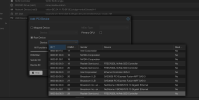I am experimenting with Proxmox for the first time by trying to virtualize my Unraid environment alongside a new Windows environment. I am using PCI passthrough on my HBA so that Unraid can see my disks no differently than running on bare metal. I also have two NVMe SSDs that Unraid uses for a BRTFS RAID1 cache drive and a third NVMe SSD that I hoped to use with my new Windows VM. However, when I go to add the NVMe drives to their respective VMs, I am only seeing the one NVMe controller and not the individual drives:

Is this expected? Or is there a way of doing passthrough at the drive level (as opposed to the controller level) for NVMe drives? Thanks!

Code:
root@nas:~# lspci
00:00.0 Host bridge: Intel Corporation Device a740 (rev 01)
00:01.0 PCI bridge: Intel Corporation Device a70d (rev 01)
00:02.0 VGA compatible controller: Intel Corporation Raptor Lake-S GT1 [UHD Graphics 770] (rev 04)
00:06.0 PCI bridge: Intel Corporation Raptor Lake PCIe 4.0 Graphics Port (rev 01)
00:14.0 USB controller: Intel Corporation Device 7a60 (rev 11)
00:14.2 RAM memory: Intel Corporation Device 7a27 (rev 11)
00:14.3 Network controller: Intel Corporation Device 7a70 (rev 11)
00:15.0 Serial bus controller: Intel Corporation Device 7a4c (rev 11)
00:15.1 Serial bus controller: Intel Corporation Device 7a4d (rev 11)
00:15.2 Serial bus controller: Intel Corporation Device 7a4e (rev 11)
00:15.3 Serial bus controller: Intel Corporation Device 7a4f (rev 11)
00:16.0 Communication controller: Intel Corporation Device 7a68 (rev 11)
00:17.0 SATA controller: Intel Corporation Device 7a62 (rev 11)
00:19.0 Serial bus controller: Intel Corporation Device 7a7c (rev 11)
00:19.1 Serial bus controller: Intel Corporation Device 7a7d (rev 11)
00:1b.0 PCI bridge: Intel Corporation Device 7a40 (rev 11)
00:1b.4 PCI bridge: Intel Corporation Device 7a44 (rev 11)
00:1c.0 PCI bridge: Intel Corporation Device 7a38 (rev 11)
00:1c.2 PCI bridge: Intel Corporation Device 7a3a (rev 11)
00:1c.4 PCI bridge: Intel Corporation Device 7a3c (rev 11)
00:1d.0 PCI bridge: Intel Corporation Device 7a30 (rev 11)
00:1d.4 PCI bridge: Intel Corporation Device 7a34 (rev 11)
00:1f.0 ISA bridge: Intel Corporation Device 7a04 (rev 11)
00:1f.3 Audio device: Intel Corporation Device 7a50 (rev 11)
00:1f.4 SMBus: Intel Corporation Device 7a23 (rev 11)
00:1f.5 Serial bus controller: Intel Corporation Device 7a24 (rev 11)
01:00.0 VGA compatible controller: NVIDIA Corporation Device 2702 (rev a1)
01:00.1 Audio device: NVIDIA Corporation Device 22bb (rev a1)
02:00.0 Non-Volatile memory controller: Realtek Semiconductor Co., Ltd. RTS5763DL NVMe SSD Controller (rev 01)
04:00.0 Non-Volatile memory controller: Realtek Semiconductor Co., Ltd. RTS5763DL NVMe SSD Controller (rev 01)
06:00.0 Ethernet controller: Intel Corporation Ethernet Controller I225-V (rev 03)
07:00.0 PCI bridge: PLX Technology, Inc. PEX 8724 24-Lane, 6-Port PCI Express Gen 3 (8 GT/s) Switch, 19 x 19mm FCBGA (rev ca)
08:00.0 PCI bridge: PLX Technology, Inc. PEX 8724 24-Lane, 6-Port PCI Express Gen 3 (8 GT/s) Switch, 19 x 19mm FCBGA (rev ca)
08:08.0 PCI bridge: PLX Technology, Inc. PEX 8724 24-Lane, 6-Port PCI Express Gen 3 (8 GT/s) Switch, 19 x 19mm FCBGA (rev ca)
08:09.0 PCI bridge: PLX Technology, Inc. PEX 8724 24-Lane, 6-Port PCI Express Gen 3 (8 GT/s) Switch, 19 x 19mm FCBGA (rev ca)
09:00.0 Serial Attached SCSI controller: Broadcom / LSI SAS3008 PCI-Express Fusion-MPT SAS-3 (rev 02)
0b:00.0 Serial Attached SCSI controller: Broadcom / LSI SAS3008 PCI-Express Fusion-MPT SAS-3 (rev 02)
0c:00.0 Ethernet controller: Broadcom Inc. and subsidiaries NetXtreme II BCM57810 10 Gigabit Ethernet (rev 10)
0c:00.1 Ethernet controller: Broadcom Inc. and subsidiaries NetXtreme II BCM57810 10 Gigabit Ethernet (rev 10)
0d:00.0 Non-Volatile memory controller: Realtek Semiconductor Co., Ltd. RTS5763DL NVMe SSD Controller (rev 01)
root@nas:~#Is this expected? Or is there a way of doing passthrough at the drive level (as opposed to the controller level) for NVMe drives? Thanks!

